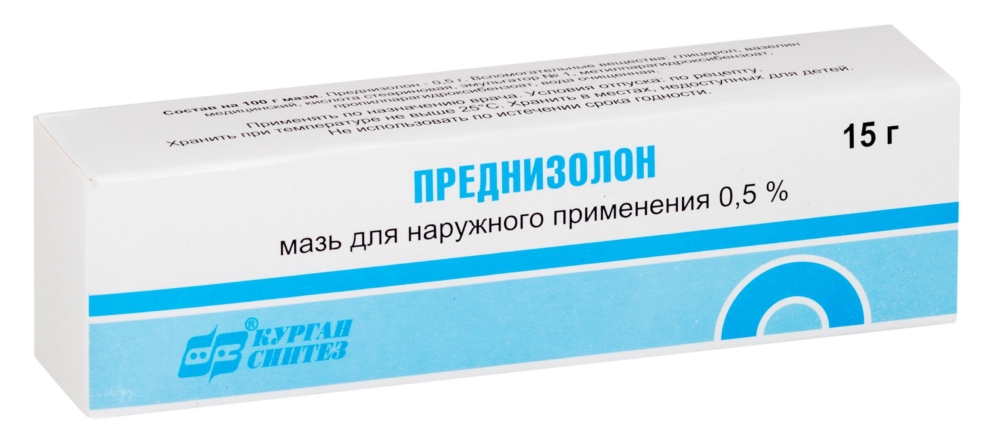The use of local therapeutic agents based on corticosteroids may be necessary for the treatment of inflammatory pathologies of the skin. Prednisolone ointment is a fairly strong first-line hormonal drug. It is in demand due to its active properties, due to which accelerated tissue regeneration occurs.
Material Content:
The composition of the drug
The central active compound of the ointment is the synthetic hormone of medium strength, prednisone, which is present in an amount of 5 mg. The following components form the auxiliary base of the glucocorticoid preparation: paraffin, methylparaben, stearic acid, emulsifier, propylparaben, glycerin. Additional compounds provide maximum absorption of the drug in the affected foci, and also create a protective layer that prevents infection of tissues.
What helps prednisolone ointment
This drug has anti-allergic, immunosuppressive and anti-inflammatory activity. Due to the presence of synthetic glucocorticoid hormone inhibition, the accumulation of tissue macrophages and leukocytes in the damaged area is inhibited. Due to this, the inflammatory process is stopped. Prednisone ointment is used in the case of various skin lesions of a non-infectious nature.
- Hives.
- Psoriasis.
- Seborrheic or atopic dermatitis.
- Lupus erythematosus.
- Some types of neurodermatitis (limited, diffuse).
- Rectal fissures, hemorrhoids.
- Toxedermia (inflammation of the skin of an acute course due to exposure to chemicals).
- Hypodermic tissue edema.
- Allergic manifestations.
- Alopecia (full or partial).
- Eye diseases that are accompanied by inflammation.
- Rhinitis of an allergic nature.
- Eczema.
- Pink lichen.
But also the drug is often involved in local inflammation as a result of an insect bite. Experts recommend the use of this ointment to provide decongestant, antiproliferative and antiexudative effects. The steroidal anti-inflammatory drug is able to quickly stop almost all clinical manifestations of pathological conditions of an allergic nature. Also, a glucocorticosteroid is in demand to eliminate puffiness and redness of the epidermis, which were provoked by the inflammatory process.
A number of components in the composition of the medication is capable of exerting an analgesic effect, eliminating severe burning, itching and pain. Anesthetic effect is possible due to the suppression of the production of lipid hormone-like active substances. Often, the tool can be used with profuse exfoliation of the upper layer of the epidermis. Prednisolone-based eye drops are quite popular in ophthalmic practice and are used to treat allergic conjunctivitis.
Instructions for use
Therapeutic treatment with this drug is carried out exclusively externally. The annotation for use indicates that the drug is prescribed only by the attending physician. Inflammatory skin pathologies can be caused not only by disorders in the immune system, but also by viruses, bacteria or fungi. And in such cases, antiviral or antibiotic drugs are used, the use of hormonal ointments is strictly prohibited.
Glucocorticoid preparation should be applied in a small amount to the inflamed area of the skin up to three times a day. The treatment regimen is prescribed by a specialist strictly individually. According to the instructions for use, the duration of therapy is up to two weeks. To prevent overdose at the end of the treatment course, the frequency of use must be reduced. Also, to enhance the effect, it is recommended to apply a sterile dressing after applying the ointment.
During pregnancy and lactation
This hormone-based drug has the ability to penetrate deep into the tissue, as well as into the systemic circulation. Based on this, prednisolone ointment is forbidden to use during pregnancy. The drug is prescribed only in rare cases when the positive effect exceeds the potential threat to the fetus. Also, the main active compound is able to cross the placental barrier and excreted in breast milk, so during treatment should stop feeding.
Drug interaction
Quite often, prednisolone is prescribed in combination with antiseptic solutions and regeneration stimulants. However, these funds should be applied separately and wait an interval of 60 minutes. In addition, it is strictly forbidden to combine hormonal ointment with drugs that contain salicylates. This interaction greatly increases the risk of bleeding. Also, adjacent use with diuretics is not allowed, since the violation of the water-electrolyte balance is not excluded.
Concurrent use of corticosteroids with cardiac glycosides can lead to hypoglycemic syndrome, which is characterized by an imbalance in the glucose level in the regulatory system. Also, anticoagulants of indirect action should not be used together with ointment, since an anticoagulant effect is not excluded. Alcohol-containing drinks are not able to affect the components of this drug.
Contraindications and side effects
There are a number of physiological and pathological disorders in which the application of this hormonal ointment is completely excluded.
- Itsenko-Cushing's syndrome, due to which there is an increased production of hormones in the adrenal cortex.
- Recently vaccinated.
- A number of diseases of infectious origin (chickenpox, measles, herpes).
- Pathological diseases of a bacterial, viral or fungal nature.
- Lupus.
- Secondary syphilis, as a result of which the appearance of rashes is noted.
- Acne.
- Oncological manifestations on the skin.
- Open damage, scratches, cracks, abrasions, cuts.
- Perioral dermatitis.
- The patient's age is up to two years.
The specialist carefully examines the patient’s history and prescribes hormonal ointment only in the absence of any contraindications. External use of the drug can provoke the development of adverse reactions on the skin, especially under the influence of individual intolerance to certain components. As a rule, side effects appear as an allergic reaction. Patients experience rashes, swelling, redness, severe itching and burning, and hives.
Prolonged use of the medication can lead not only to the development of signs of an overdose, but also can cause hypercorticism. A similar phenomenon is due to the fact that the central compound of the drug is able to accumulate in the tissues and body. In this case, the patient is advised to consult a doctor who will review the treatment regimen or replace the therapeutic agent.
Analogues of glucocorticoid ointment
In some cases, it may be necessary to select analogues of the prednisolone ointment. Analogues include drugs of steroidal origin, which have a similar pharmacological effect, as well as an identical component composition. Replace hormonal ointment with the following means:
- Fusimet - this ointment is prescribed for purulent-inflammatory processes on the skin, and the drug is also used to treat severe burns;
- Petroleum - the drug refers to non-steroidal substitutes for prednisolone ointment and is recommended in case of chronic skin diseases;
- Decortin - ointment is quite effective for systemic pathological skin diseases.
Also, analogues of this medication include Akriderm, Triderm, Uniderm, Medopred. To select a similar medicine, you need to consult a specialist who will select the drug, taking into account the history and personal examination of the patient.
















